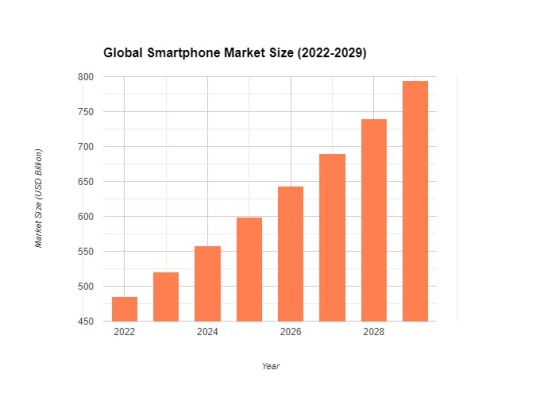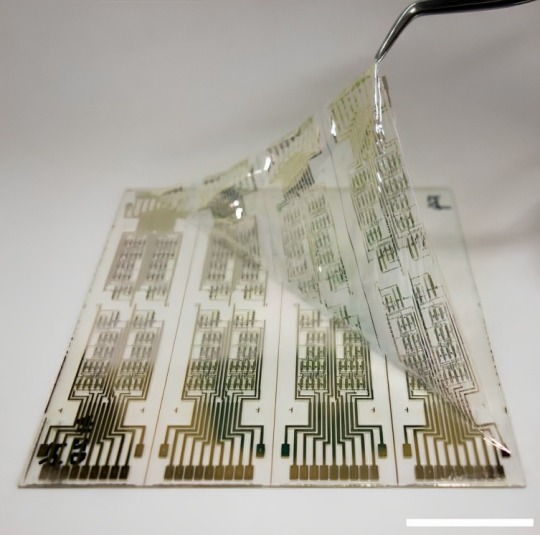#Global Foldable Display Market Size
Text
Global Foldable Display Market Size, Market Segmentation and Future Forecasts to 2030
Global Foldable Display Market Size, Share, Trend, Growth and Global Opportunity Analysis and Industry Forecast, 2023-2030.
Overview
The Global Foldable Display Market is likely to exhibit steady growth over the forecast period, according to the latest report on Qualiket Research.
Global Foldable Display Market was valued at USD 295.50 Million in 2021 and is slated to reach USD 7573.4 Million by 2027 at a CAGR of 52.8% from 2022-2027.
A foldable display is a type of flexible electronic display that is distinct from standard flat-surface displays. Flexible display technology is used in foldable displays, which can be rolled up, twisted, and folded like paper. Foldable displays are far more durable than standard displays. These displays are a new technology that is expected to revolutionize the electronics and semiconductor industries shortly. Foldable displays are common in smartphones, tablets, and notebook computers.
Key Players:
Kateeva (U.S.), SONY INDIA (India), Pioneer Corporation (Japan), AUO Corporation (Taiwan), BOE Technology Group Co., Ltd (China), Samsung (South Korea), LG Display (South Korea), Panasonic Corporation Co, Ltd (Japan), RITEK CORPORATION (Taiwan), OSRAM GmbH (Germany).
Request A Free Sample: https://qualiketresearch.com/request-sample/Foldable-Display-Market/request-sample
Market Segmentation
Global Foldable Display Market is segmented into By Technology, Material, Type, Panel Size, and Application. By Technology such as Organic Light-Emitting Diode (OLED), Liquid Crystal Display (LCD), and Electronic Paper Display (EPD). By Materials such as Glass, Metal, and Plastic. By Types such as Curved Display, Bendable, and Foldable Display, Rollable Display. By Panel Size such as Up to 6”, Above 50”, 20-50”, and 6-20”. By Applications such as Wearable, TVs, Smartphones, Smartwatches, E-readers, Automotive, and Transportation.
Regional Analysis
Global Foldable Display Market is segmented into five regions Americas, Europe, Asia-Pacific, and the Middle East & Africa. Due to the increasing production of smartphones with advanced display technologies, primarily in developing countries such as India and China, Asia-Pacific dominates the foldable display market in terms of revenue and market share. Furthermore, increased R7D expenditure by major market players in this region will drive market growth even further. Because of the increasing applications of foldable displays in television and smartphone displays in this region, North America will continue to project the highest growth rate during the forecast period of 2022-2027.
About Us:
QualiKet Research is a leading Market Research and Competitive Intelligence partner helping leaders across the world to develop robust strategy and stay ahead for evolution by providing actionable insights about ever changing market scenario, competition and customers.
QualiKet Research is dedicated to enhancing the ability of faster decision making by providing timely and scalable intelligence.
QualiKet Research strive hard to simplify strategic decisions enabling you to make right choice. We use different intelligence tools to come up with evidence that showcases the threats and opportunities which helps our clients outperform their competition. Our experts provide deep insights which is not available publicly that enables you to take bold steps.
Contact Us:
6060 N Central Expy #500 TX 75204, U.S.A
+1 214 660 5449
1201, City Avenue, Shankar Kalat Nagar,
Wakad, Pune 411057, Maharashtra, India
+91 9284752585
Sharjah Media City , Al Messaned, Sharjah, UAE.
+91 9284752585
0 notes
Text
Pedalling Towards Wellness: The Rise of Electric Cycles for Corporate Employees

Solutions for Sustainable Mobility
E-cycles serve as a solution to stay healthy, be active, and contribute positively to the environment and economy as well. For those who have enjoyed biking in their youth and are looking to pick up the habit again in adulthood, the ecycle has re-opened the door to a favourite childhood pastime that is enjoyable and a healthy way to be engaged in a fun activity.
Emotorad manufactures our ebikes and safety gear cycling equipment in India. This is taking the country by storm and pushing the generation into a whole new sphere of easy commute and fun adventure. The size of the Global Electric Bike Market is predicted to reach USD 109.53 billion with a CAGR of 10.21% by 2030, and Emotorad is a name to reckon with at the forefront of global distribution.
Ebiking is ideal for seasoned or newbie cyclists and provides a natural motivation to embark on a new adventure. Many corporate employees are becoming aware of electric bicycles by saying it on the road and through someone in their circles, and it is gaining momentum.
Many companies are trying to incentivise and encourage employees to use ebikes to promote their health by offering subsidies and freebies. Such corporate tie-ups are fruitful and help companies promote healthy minds and bodies in the office. They also aid in reducing the demand for parking spots in urban areas.
STAY GREEN AND ECO-FRIENDLY - PRESERVE THE ENVIRONMENT
Image Source
E-cycles are a harbinger of environmental safety. They do their part in keeping the planet clean and bringing down pollution levels. They are the lone vehicles on the road, not contributing harmful carbon emissions.
Ebikes can be charged easily, they are sturdy on rough terrain, and the controller and display panel are right there on the handlebar when you need the pedal assist to full throttle all the way! With the T-Rex Air in your corner, you can roll on wheels with no hassle, and getting the battery back to full charge takes only 4 hours, so it’s a perfect pick for your daily commute.
KICKSTART A HEALTHY AND ADVENTUROUS LIFESTYLE
Comfortable riding is the best way to maximise your time and effort, and pushing the dimensions of your physical ability is necessary to keep fit in a healthy way. The ebike ticks all these goals and propels you into a dynamic daredevil on wheels.
Ride around parks, to work, and through trails in beautiful spots around the city.
Read our exciting blog to find more cool hidden cycle trails in and around Pune city.
Another popular reason to purchase an ebike is so that individuals can maintain their health at an optimum level. You have to think in terms of range and comfort when you’re going to work and find the bike that excels in that area.
BOOST BRAINPOWER AND MENTAL HEALTH
Image Source
Movement allows the blood and oxygen in your system to move freely, and biking will assist you in checking this daily target off in a positive way. Pedalling through natural landscapes has a calming effect on the body and allows us to be fully present in the experience. Busy work schedules are the norm, but even 20 minutes a day on an ebike, you’re well within the realm of a good serotonin hit!
E-biking on a smooth road on a breezy day feels like riding in HD. Exposure to natural stimuli in different environments takes away routine monotony and gives rise to fresh perspectives. When in this state, the flow of positive chemicals in the body, like neurotransmitters and endorphins, provides joyful feelings and boosts well-being. Maintaining a positive mindset benefits us across all areas of life.
Emotorad’s versatile ebikes feature compact and foldable frames, durable tyres, and LED screens, making them ideal for daily commutes.
TIME MANAGEMENT AND COST SAVINGS
Getting stuck in traffic is a b!*&#! Cycling to work enables employees to cut down commute time and avoid sticky traffic congestion. E-bikes get you to your destination in the nick of time, and with rush hour traffic blocking off all main routes, e-bike riders have become efficient at nipping through nooks of the city to make their way through.
Corporate employees using designated cycle trails will likely be on time to work as they can easily navigate traffic. The overall time and boost to your health is a compelling reason to follow this trend; not to mention the moolahs you save in cab or bus fares which add up to a pretty little chunk at the end of a month. So, pick a model that suits your needs and pedal your way into wellness.
E-cycles serve as a solution to stay healthy, be active. For those who have enjoyed biking in their youth and are looking to pick up the habit again in adulthood, the ecycle has re-opened the door to a favourite childhood pastime that is enjoyable and a healthy way to be engaged in a fun activity.
0 notes
Text
Analyzing Key Components in the Flexible Electronics Materials Market

In today’s rapidly evolving technological landscape, medical, automotive, and consumer electronics industries display a growing need for compact, lightweight, and cost-effective devices. In this regard, flexible electronics have captured the attention of these sectors, offering innovative solutions that enable the development of bendable systems with versatile shapes. Triton’s analysis signifies that the global flexible electronics market is anticipated to progress with a CAGR of 8.88% during the forecast period 2023-2030. The applications for organic photovoltaics (OPV), RFID, organic light-emitting diodes (OLED), and compacted printed electronic systems are experiencing a significant upsurge, which drives the demand for flexible electronics substrates.
Another notable trend fueling the market expansion is advancements in display technology, driven by the increasing demand for digital visuals. Expanding applications for advanced displays have influenced companies to pioneer advancements in flexible displays.
TCL, for instance, introduced the world’s first rollable extendable smartphone concept utilizing flexible AMOLED display technology. Additionally, haptic touch screens have recently been developed to provide users with tactile feedback via various textures or low electrical currents.
As the demand for compact products and innovative displays continues to rise, there is a promising landscape for the application of various flexible electronic components.
From Rigid to Resilient: Exploring the Potential of Key Flexible Components
Flexible Displays, typically made of OLED technology, are designed to withstand folding, bending, and twisting. Hence, they are increasingly used in foldable devices like smartphones, providing a compact storage option with a larger screen size for media display. As per Triton’s analysis, the flexible display category captured the highest share at $20263.22 million in 2022 in terms of components.
The initial appeal of folding displays lies in their novelty nature, which garnered significant attention for products like the Samsung Galaxy Fold and Motorola Razr. China’s Royole, for example, made advancements in flexible displays with its FlexPai Phone and even ventured into wearable applications such as flexible displays on t-shirts and hats.
Moreover, flexible consumer electronics are gaining popularity due to their unique characteristics, such as lightweight design, bendability, ruggedness, and lack of brittleness. In this regard, OLED displays, commonly found in smartphones, tablets, and TV screens, offer enhanced picture quality and energy efficiency through higher contrast and vibrant colors. The market holds promise for curved displays, allowing mobile phones to enhance user comfort. In terms of application, the consumer electronics category is likely to advance with 9.01% of CAGR over 2023-2030.
Flexible Sensors, also known as bend sensors, have gained significant attention for their exceptional properties like high stretchability, excellent biocompatibility, great conformability, and low cost. This has prompted various company initiatives, widening their applications in emerging fields like industrial IoT, healthcare, etc. For instance, Japan Display Inc developed the world’s first flexible low-temperature polysilicon thin-film transistor tactile sensor.
In recent years, wearable biosensors for health monitoring have gained considerable attention as they enable real-time health status monitoring, measuring various parameters like glucose, lactate, pH, cholesterol, pulse rate, temperature, etc. In this regard, using solution-based nanomaterials processed through printing techniques holds promise for cost-efficient manufacturing on flexible polymeric substrates. Per our analysis, the medical and healthcare category is estimated to witness the fastest growth at a CAGR of 9.23% during the 2023-2030 forecast period.
Flexible Photovoltaics is projected to emerge as the fastest-growing component between 2023 and 2030, growing at a CAGR of 9.30%. Thin film PV, a cost-effective alternative to traditional crystalline Si-based PV, offers flexibility and new design possibilities for solar cells. Flexible PV devices are highly sought-after for indoor and outdoor applications due to their ability to integrate with structures of different shapes and sizes. Furthermore, flexible PV modules possess faster payback than conventional ones. As a result, various PV materials have been developed using different deposition methods on flexible substrates.
Flexible Electronics Market: Industry 4.0 and Smart Homes to Accommodate Opportunities
With advancing technology, factories are increasingly embracing automation and connectivity, leading to the rise of Industry 4.0. This paradigm shift involves automating manufacturing processes and upgrading architectures to enhance productivity. Within the industrial platform, electronic design, development, manufacturing, assembly, and distribution hold significant importance.
Furthermore, there is a surge in the adoption of wearables, portable devices, and remotely connected devices across various sectors, such as automotive and smartphones. In this context, flexible electronic devices play a pivotal role, enabling machine-to-machine and human-to-machine connections. Moreover, they offer numerous advantages over non-flexible counterparts, including cost-effectiveness, reduced energy consumption, and lightweight construction.
Integrating physical manufacturing activities with machine learning, artificial intelligence, big data, Industry 4.0, and industrial IoT further drives the application of flexible electronic materials in industrial manufacturing. For instance, robots, sensors, and RFID tags find extensive use in tracking product movement and other operational functions.
Therefore, the proliferation of connected devices contributes heavily to the growing demand for flexible electronics in smart homes, which opens new avenues for the flexible electronics market.
FAQs:
Q1) What is the global flexible electronics market size?
In 2022, the global flexible electronics market attained $37634.72 million and is expected to garner $74779.19 million by 2030.
Q2) What are the key applications of flexible electronics?
The key applications of flexible electronics include consumer electronics, medical and healthcare, automotive, and energy sectors.
#Flexible Electronics Market#Consumer Goods & Services#Consumer Electronics#triton market research#market research reports
0 notes
Text
Smartphone Market: Size, Trends, Players, and Outlook
Smartphones have become an undeniable cornerstone of modern life, seamlessly integrating into our work, entertainment, and communication. This article delves into the current state of the ever-evolving smartphone market, exploring its size, market share, growth trajectory, and the key trends shaping its future.
Smartphone Market Size and Share:
The smartphone market boasts a remarkable size, reaching a staggering USD 484.81 billion in 2022 and projected to reach USD 792.51 billion by 2029, exhibiting a healthy CAGR of 7.3%. This growth can be attributed to several factors, including:
Rising disposable income: Increasing disposable income, particularly in developing economies, empowers individuals to invest in sophisticated smartphones.
Technological advancements: Continuous advancements in display technology, camera capabilities, processing power, and battery life fuel consumer demand for the latest smartphones.
Expanding internet penetration: Growing accessibility to high-speed internet globally drives the need for advanced devices to access online services and applications.

The market share is dominated by a few major players, with Samsung and Apple holding a combined share of over 50%. These giants consistently innovate and offer premium flagship devices, attracting a loyal customer base. However, the market is becoming increasingly competitive with established players like Xiaomi, Oppo, Vivo, and others making significant strides, particularly in the mid-range and budget segments.
Smartphone Sector Growth and Revenue:
The smartphone sector is expected to witness continued growth, driven by the factors mentioned above. The projected CAGR of 7.3% translates to a market size exceeding USD 792.51 billion by 2029. This growth will be fueled by:
Emerging markets: Developing economies like India, Southeast Asia, and Africa will be key drivers of market growth as smartphone penetration increases.
5G technology adoption: The widespread adoption of 5G networks will create demand for next-generation smartphones capable of handling faster data speeds and enabling innovative applications.
Focus on innovation: Smartphone manufacturers will continue to invest in research and development, focusing on areas like foldable displays, artificial intelligence integration, and enhanced camera functionalities.
Smartphone Industry Trends:
Several trends are shaping the future of the smartphone industry:
Artificial intelligence (AI) integration: AI features like facial recognition, voice assistants, and intelligent camera functionalities are becoming increasingly sophisticated, transforming user experience.
Focus on foldable displays: Foldable phones continue to evolve, offering a unique user experience and potentially disrupting the traditional smartphone form factor.
Sustainability initiatives: Consumers are increasingly environmentally conscious, prompting smartphone manufacturers to adopt eco-friendly practices and materials in device production and packaging.
Rise of the "phygital" experience: The integration of online and offline shopping experiences, where physical and digital elements combine, is influencing smartphone sales strategies.
Smartphone Market Players:
The smartphone market landscape features a diverse range of players. Established giants like Samsung and Apple remain dominant forces, while Chinese manufacturers like Xiaomi, Oppo, and Vivo are gaining significant market share, particularly in the affordable segment. Additionally, niche players like Google with its Pixel series and emerging brands are catering to specific consumer segments.
Smartphone Market Future Outlook:
The future of smartphone market appears bright, with continued growth and innovation anticipated. As technology advancements accelerate, user demands evolve, and emerging markets expand, the industry will see further diversification and competition.
However, challenges in the form of chip shortages, supply chain disruptions, and rising manufacturing costs will need to be addressed to ensure sustained growth. Additionally, navigating the evolving regulatory landscape across different geographical regions remains a challenge for smartphone manufacturers.
In conclusion, the smartphone market remains a dynamic and vital sector within the global technology landscape. By embracing innovation, catering to diverse consumer needs, and prioritizing sustainability, smartphone manufacturers can ensure their success in the ever-unfolding story of this ever-present device. As technology continues to progress and user expectations change, the smartphone of tomorrow promises to be even more sophisticated, versatile, and seamlessly integrated into our lives.
1 note
·
View note
Text
Source Driver IC Market Growth, Trend, and Prospects from 2023–2030

Source Driver IC Market Growth
The Source Driver IC Market is expected to grow from USD 1.30 Billion in 2022 to USD 2.90 Billion by 2030, at a CAGR of 10.70% during the forecast period.
Get a Sample PDF of the report: https://www.reportprime.com/enquiry/sample-report/11290
Source Driver IC Market Size
Source Driver IC is an electronic device used to control the flow of power to display pixels in LCD and LED screens. The global Source Driver IC market research report provides insights into the market segments based on type, application, and region. The market segments for types of Source Driver IC are 8 Channel Source Driver IC, 16 Channel Source Driver IC, and Other. The market segments for application are Industrial, Automotive, Telecommunications, and Other. The report covers the regions of North America, Asia Pacific, Middle East, Africa, Australia, and Europe. The leading market players in the industry are Texas Instruments, Macroblock, Analog Devices, LX Semicon, Himax Technologies, Solomon Systech, and Sitronix Technology. Regulatory and legal factors specific to the market conditions are also assessed to provide an in-depth understanding of the industry’s regulatory framework. The report offers valuable insights into the Source Driver IC market, including drivers, restraints, opportunities, and challenges that will guide investors, stakeholders, and industry players to make strategic decisions.
Source Driver IC Market Key Players
Major Key Player is listed in the Source Driver IC Market
Texas Instruments
Macroblock
Analog Devices
LX Semicon
Himax Technologies
Buy Now & Get Exclusive Discount on this:https://www.reportprime.com/enquiry/request-discount/11290
Source Driver IC Market Segment Analysis
The Source Driver IC market is witnessing significant growth in recent years due to the unprecedented rise of demand for advanced displays in various industries like automotive, healthcare, consumer electronics, and others. The global Source Driver IC market is growing at a CAGR of 17.5%, and it is expected to reach $ 1.23 billion by 2026 from $ 391 million in 2020.
One of the major factors that drive the revenue growth of the Source Driver IC market is the increase in demand for flexible displays that enable curved or foldable screens. The advantages of flexible displays like high contrast, lightweight, and less power consumption significantly drive the demand for the Source Driver IC market. The technological advancements in display technologies such as OLED, AMOLED, and flexible displays are expected to boost the growth of the Source Driver IC market.
Another major driving factor for the Source Driver IC market’s revenue growth is the increasing popularity of HD-quality displays in various applications, including TVs, touchscreens, and wearables. Additionally, the rise in demand for energy-efficient displays is expected to increase the Source Driver IC market’s demand.
The latest trends that the Source Driver IC market follows include the development of high-quality drivers for high-resolution displays, increasing demand for intelligent power management chips, and the growing focus on advanced technology-based display solutions.
However, the market faces some significant challenges, including high prices of advanced display technologies and the threat from substitutes such as LCD displays, which are less expensive. Also, the lack of skilled labor and other resources for manufacturing Source Driver ICs is expected to hinder the market’s growth.
The report’s main findings show that the Asia-Pacific region holds the largest market share in the Source Driver IC market due to the rising demand for smartphones, tablets, and other consumer electronics. The report also suggests that key companies’ strategies to expand and enhance their product offerings will significantly drive the market’s growth.
In conclusion, the Source Driver IC market is growing rapidly due to the increasing demand for high-quality displays and technological advancements. However, to maintain this growth rate, manufacturers must develop affordable display solutions and invest in new technologies to overcome the market challenges.
This report covers impact on COVID-19 and Russia-Ukraine wars in detail.
Market Segmentation (by Application)
Industrial
Automotive
Telecommunications
Other
Information is sourced from https://www.reportprime.com/
Purchase This Report: https://www.reportprime.com/checkout?id=11290&price=3590
0 notes
Text
Mobile Phone Chipsets Market Size, Type, segmentation, growth and forecast 2023-2030

Mobile Phone Chipsets Market
The Mobile Phone Chipsets Market is expected to grow from USD 2.00 Billion in 2022 to USD 4.00 Billion by 2030, at a CAGR of 8.80% during the forecast period.
Mobile Phone Chipsets Market Size
Mobile phone chipsets are the essential components that drive the performance of mobile phones. These chipsets comprise of separate or integrated chips that allow the device to function in line with the user's requirements. The mobile phone chipset market is segmented based on type, application, and region. 5G and 4G mobile phones are the most extensively used applications of chipsets. The Asia-Pacific region currently holds the largest share in the global market, followed by North America and Europe. The market players include Apple, Huawei, Intel, MediaTek, Qualcomm, Samsung, Unisoc/Tsinghua Unigroup, and Nvidia. Regulatory and legal factors specific to market conditions are critical as they affect the overall growth of the market. Factors such as government policies on data privacy, restrictions on imports and exports, and intellectual property laws can impact the chipset market. In conclusion, the mobile phone chipset market is a crucial aspect of the mobile phone industry, and the market is expected to witness steady growth in the coming years.
Mobile Phone Chipsets Market Key Player
Apple
Huawei
Intel
MediaTek
Qualcomm
Buy Now & Get Exclusive Discount on this https://www.reportprime.com/enquiry/request-discount/11191
Mobile Phone Chipsets Market Segment Analysis
Mobile phone chipsets are widely used in smartphones and other mobile devices to provide hardware support for data processing, multimedia and communication functions. The global mobile phone chipsets market is expected to grow significantly in the coming years due to the increasing demand for advanced smartphones and other mobile devices.
The major factors driving revenue growth in the mobile phone chipsets market include the increasing adoption of 4G and 5G technologies, the surge in demand for smartphones and tablets, and the rising trend of mobile gaming. In addition, the growing demand for high-speed internet connectivity, improved graphics and audio features, and longer battery life is also driving the growth of the mobile phone chipsets market.
The latest trends followed by the mobile phone chipsets market include the increasing integration of artificial intelligence, machine learning, and augmented reality technologies in mobile devices. Additionally, the increasing popularity of foldable smartphones and flexible displays is also driving innovation in the mobile phone chipset market.
Despite the positive market trend, the mobile phone chipsets market is also facing several challenges such as intense competition among manufacturers, the high cost of development, and the limited lifespan of mobile devices. Furthermore, the frequent changes in technology and the need for high-end specifications are also significant challenges faced by the mobile phone chipsets market.
The main findings of the report highlight the increasing demand for 5G chipsets due to the adoption of 5G networks worldwide. Additionally, the report also points out the growing trend of lower-priced smartphones in emerging markets. The report recommends that manufacturers focus on innovation by investing in R&D to produce high-quality chipsets with advanced functionalities to meet the evolving demands of the market.
In conclusion, the mobile phone chipsets market is expected to continue to grow due to the increasing complexity of mobile devices and the need for advanced features. Manufacturers need to maintain their competitive edge by focusing on innovation and technology advancements to meet the market's evolving demands.
This report covers impact on COVID-19 and Russia-Ukraine wars in detail.
Purchase This Report: https://www.reportprime.com/checkout?id=11191&price=3590
Market Segmentation (by Application):
5G Mobile Phone
4G Mobile Phone
Others
Information is sourced from www.reportprime.com
0 notes
Text
What is the most common screen size?
As technology advances, screen sizes have evolved significantly over the years. From the tiny screens of the first computers and mobile phones to the large TV and monitor screens we see today, displays have gotten bigger and smaller depending on the device. But among all the various screen sizes available, which one can be considered the most common or standard size nowadays? Let's take a look at the most popular screen resolutions and how they have changed over time.

The Evolution of Screen Sizes
When computers first emerged in the 1980s, screen sizes were relatively small due to limitations in technology at the time. Most computer monitors ranged from around 9-15 inches diagonally. As the 1990s rolled around, CRT monitors started becoming more common in the 17-21 inch range. These larger sizes provided more usable screen real estate for software applications and multimedia content.
In the late 90s and early 2000s, LCD flat panel displays started entering the consumer market, bringing even bigger and thinner screens. LCD TVs in the 20-30 inch range became widespread in homes. Laptop screen sizes also increased significantly during this era, with 15-17 inches becoming standard on portable PCs. By the mid-2000s, LCD had almost completely replaced bulky CRT monitors, with 19-22 inches becoming the norm for desktop computer displays.
The Rise of Mobile Devices
The smartphone revolution of the late 2000s greatly impacted screen sizes across all devices. The arrival of the iPhone in 2007 with its 3.5 inch display established mobile phones as portable media computers. Over time, screens gradually increased to 4-5 inches on Android phones to match the larger canvases needed for modern apps and content. Tablets then popularized even bigger 10-12 inch screens for portable media consumption and lightweight productivity.
As touchscreens improved, they started replacing laptops and desktops for many basic tasks. "Phablet" devices in the 5.5-6.5 inch range emerged as a cross between phones and tablets. This brought down the average screen size as mobile phones became people's primary computers.
Now in the 2020s, screens have fragmented across different form factors once again. Foldable and dual-screen devices are experimenting with new form factors.
Surveying the Most Common Sizes Today
So based on current usage trends, what would be considered the most widely-used screen resolution globally? Here are the top contenders:
1080p (1920x1080)
The HD 1080p resolution has been the standard screen size for laptops, desktop monitors, and LED-LCD TVs for over a decade now. It provides a good balance of pixel density and affordability. Over 60% of all computer displays worldwide are estimated to be 1080p.
1366x768
Slightly lower than 1080p, the 1366x768 resolution remains very common on lower-cost laptops and some budget desktop monitors. While not quite HD-level quality, it's still sufficient for basic computing needs.
720p (1280x720)
As the baseline HD resolution, 720p screens are found on millions of smartphones, tablets, low-end laptops, and entry-level LED TVs. With its compact size and high pixel density, 720p continues to dominate the mobile space.
Analyzing Screen Size Trends
Taking a step back, some broader trends are apparent from the evolution of screen sizes:
Bigger is generally better for stationary desktop use cases where screen real estate isn't an issue. Most desktop monitors today are in the 20-27 inch range.
For portable laptops, 15-17 inches has long been the sweet spot balancing mobility and usability. 13-14 inches remains popular for ultra-thin ultraportables.
Mobile devices favor compact sizes that fit in pockets and hands. The 5-6.5 inch range reigns supreme for phones, with 7-12 inches for tablets.
Higher resolutions are prioritized on devices viewed up-close like phones, VR headsets, and high-end monitors. Lower resolutions suffice for TV viewing distances.
Affordability remains a major decision factor. 1080p and 720p continue selling in huge volumes due to their cost-effective ratios of quality to price.
So in summary, while screen sizes have proliferated across different applications, 1080p and 720p remain the most ubiquitously used resolutions spanning laptops, desktops, TVs, and mobile devices. Their pixel densities meet most general use cases while staying reasonably priced.
Key Takeaways and the Road Ahead
To conclude, here are the main highlights from this analysis of common screen sizes:
1920x1080 (1080p) has emerged as the de facto standard desktop/laptop/TV resolution, found on over 60% of displays worldwide.
1366x768 and 1280x720 (720p) resolutions remain extremely prevalent on budget portable devices and entry-level TVs.
Bigger stationary screens balance functionality while smaller mobile sizes optimize for portability.
Higher pixel density is prioritized for personal electronics viewed up-close versus distances like TVs.
Cost and compatibility along with improving technology will continue shaping typical screen sizes over time.
As new innovations like 8K, foldables, dual/multi-screen devices, and micro/mini LED screens develop, screen sizes may fragment further across specialized contexts. But for general purpose use, 1080p and 720p are likely to hold their ground as the most popular resolutions for balanced high quality and affordability going into the future.
0 notes
Text
Ultra-Thin Glass Market Is Estimated To Witness High Growth Owing To Increasing Demand for Lightweight and Flexible Displays

The global Ultra-Thin Glass Market is estimated to be valued at US$ 11.66 billion in 2022 and is expected to exhibit a CAGR of 7.2% over the forecast period 2023-2030, as highlighted in a new report published by Coherent Market Insights.
Market Overview:
Ultra-thin glass is a specialty glass with thickness ranging from 0.1mm to 0.5mm. It is widely used in various industries such as electronics, automotive, and solar panels. The key advantage of ultra-thin glass is its lightweight and flexibility, which makes it suitable for applications such as displays, touchscreens, and solar cells. The growing demand for lightweight and flexible displays in smartphones, tablets, and wearable devices is driving the market growth. Ultra-thin glass offers several advantages over traditional glass, including improved optical properties, durability, and enhanced performance.
Market Key Trends:
One key trend in the ultra-thin glass market is the increasing adoption of foldable smartphones and wearable devices. Foldable smartphones require flexible and durable displays, which can be achieved using ultra-thin glass. Companies like Samsung and Huawei have already launched foldable smartphones with ultra-thin glass displays. This trend is expected to drive the demand for ultra-thin glass in the coming years.
For example, Corning Inc., one of the key players in the ultra-thin glass market, has developed a flexible glass called Willow Glass, which is used in the manufacturing of foldable smartphones and wearable devices. This ultra-thin glass offers superior flexibility and durability, making it suitable for curved displays.
PEST Analysis:
- Political: The political stability of a country can affect the manufacturing and export of ultra-thin glass. Government regulations related to environmental protection and trade policies can also impact the market.
- Economic: The economic growth of a country influences consumer spending on electronic devices, which drives the demand for ultra-thin glass.
- Social: Changing consumer preferences towards lightweight and flexible devices, as well as the increasing adoption of smart devices, are key social factors driving market growth.
- Technological: Advancements in glass manufacturing technologies, such as float glass and fusion draw processes, have enabled the production of ultra-thin glass with enhanced properties.
Key Takeaways:
- The Global Ultra-Thin Glass Market Size is expected to witness high growth, exhibiting a CAGR of 7.2% over the forecast period, due to the increasing demand for lightweight and flexible displays. The growing adoption of foldable smartphones and wearable devices is driving the market growth.
- Asia Pacific is expected to be the fastest-growing and dominating region in the ultra-thin glass market. The region is witnessing significant growth in the electronics industry, especially in countries like China, Japan, and South Korea.
- Key players operating in the global ultra-thin glass market include Corning Inc., AGC Inc., Schott AG, Nippon Electric Glass Co., Ltd., Central Glass Co., Ltd., Xinyi Glass Holdings Limited, AIR-CRAFTGLASS, NOVALGLASS, and Taiwan Glass Group. These companies are focusing on product innovation and partnerships to expand their market presence.
#Ultra-Thin Glass Market#Ultra-Thin Glass Market Outlook#Ultra-Thin Glass Market Forecast#Ultra-Thin Glass Market Analysis#Ultra-Thin Glass Value#Ultra-Thin Glass#display devices#smartphones#tablets#televisions#plastic substrates#Coherent Market Insights
0 notes
Text
Foldable Smartphone Market Is Estimated To Witness High Growth Owing To Shifting Consumer Preferences

Market Overview:
Foldable smartphones are innovative devices that offer the flexibility of a tablet and the portability of a smartphone. These devices come with a foldable display that can be expanded into a larger screen size, providing users with a unique and immersive experience. The market for foldable smartphones is driven by the increasing demand for advanced mobile devices with larger screens and improved functionality.
The global Foldable Smartphone Market Size is estimated to be valued at US$ 15.83 Bn in 2021 and is expected to exhibit a CAGR of 20.4% over the forecast period of 2021-2028, as highlighted in a new report published by Coherent Market Insights.
Foldable smartphones offer several advantages over traditional smartphones. Firstly, they provide users with a larger display area, which enhances the overall user experience. This is especially beneficial for activities such as gaming, watching videos or movies, and browsing the internet. Additionally, foldable smartphones are highly portable and can be easily carried in pockets or bags, making them ideal for on-the-go use. Furthermore, these devices offer improved multitasking capabilities, as they can be used in different configurations, such as split-screen mode or extended mode.
Market Key Trends:
One key trend in the Foldable Smartphone Market is the integration of advanced display technologies. Manufacturers are focusing on developing foldable displays with higher resolutions, improved brightness levels, and enhanced color accuracy. For example, Samsung's Galaxy Z Fold series features Dynamic AMOLED displays that deliver vibrant visuals with true-to-life colors. This trend is driven by the increasing demand for immersive multimedia experiences and high-quality visuals.
PEST Analysis:
Political: The political landscape can influence the adoption and regulation of foldable smartphones. Governments may impose import/export restrictions or impose regulations on the use of such devices.
Economic: The economic factors, including disposable income and consumer spending patterns, play a crucial role in the market growth of foldable smartphones. As economies develop and consumers have higher purchasing power, the demand for premium devices like foldable smartphones is expected to increase.
Social: The social factor revolves around consumer preferences and trends. As consumers seek advanced technologies and unique experiences, the demand for foldable smartphones is driven by social influences, such as peer recommendations and social media influence.
Technological: Technological advancements drive the growth of the foldable smartphone market. The development of flexible displays, advanced hinge mechanisms, and durable materials contribute to the improvement in the design and functionality of foldable smartphones.
Key Takeaways:
The global Foldable Smartphone Market is expected to witness high growth, exhibiting a CAGR of 20.4% over the forecast period, due to increasing consumer demand for devices with larger screens and improved functionality. For example, Huawei Mate Xs offers a larger display for gaming and multitasking purposes.
In terms of regional analysis, Asia Pacific is expected to be the fastest-growing and dominating region in the foldable smartphone market. This can be attributed to the presence of major players in the region, such as Samsung, Huawei, and Xiaomi, as well as the growing consumer base with high purchasing power.
Key players operating in the global Foldable Smartphone Market are Huawei, Lenovo Group Ltd., LG Electronics, Microsoft, Motorola, Oppo Co. Ltd, Royole, Samsung, Sony, TCL, and Xiaomi. These players are actively investing in research and development to enhance their product offerings and gain a competitive edge in the market.
In conclusion, the Foldable Smartphone Market is witnessing significant growth due to the shifting consumer preferences for larger screens and improved functionality. With advancements in display technologies and increasing investment by key players, the market is expected to flourish in the coming years.
#Foldable Smartphone Market#Foldable Smartphone Market Size#Foldable Smartphone Market Share#Foldable Smartphone Market Trends#Foldable Smartphone Market Demand#Foldable Smartphone Market Growth#Coherent market Insights
0 notes
Text

Organic thin film transistors (OTFTs) consist of organic semiconducting compounds used in electronic devices, such as computer screens, having bright displays, rich colors, quick response, and are easily readable even in ambient light. OTFTs are mechanically flexible, lightweight, and foldable products, which allow manufacturers to carry out simple production processes. The demand for OTFTs is expected to rise globally in the next four to five years, owing to their low price, compact size & reduced weight, long life, and less power consumption. However, its complex structure restrains the growth of the market. Moreover, increase in R&D activities is expected to provide new opportunities for the market.
0 notes
Text
Flexible Battery Market Global Trends, Market Share, Industry Size, Growth, Opportunities, and Market Forecast - 2022 to 2031

The Residential Battery Market is experiencing a surge in global trends, with increasing adoption of wearable devices, Internet of Things (IoT) applications, and flexible displays. These lightweight, bendable batteries are revolutionizing the electronics industry by providing power solutions for a wide range of flexible and portable devices. The market analysis highlights key trends, market share, industry size, growth factors, opportunities, and market forecasts from 2022 to 2031.
Global Trends: Advancements in materials science and nanotechnology are driving the development of high-performance materials for flexible batteries, enhancing their efficiency and energy density. The integration of nanomaterials, such as graphene and carbon nanotubes, is revolutionizing the battery's properties, making them more flexible, lightweight, and durable. Additionally, research and development efforts are focused on developing stretchable and transparent batteries for innovative applications in the electronics industry.
Market Share and Industry Size: The Residential Battery Market is witnessing significant growth and is expected to capture a substantial share of the overall battery market. The industry size is expanding as various sectors, such as consumer electronics, healthcare, and automotive, embrace flexible battery technology. Key players in the market are continuously investing in research and development to introduce advanced flexible battery solutions, driving market growth.
Growth Factors: The increasing demand for wearable devices, such as smartwatches, fitness trackers, and electronic textiles, is a primary growth factor for the flexible battery for market. The integration of flexible batteries in IoT devices, flexible displays, and electronic skin patches is also driving market expansion. Moreover, the trend of miniaturization and lightweight designs in electronics is boosting the adoption of flexible batteries, providing manufacturers with new opportunities to create innovative products.
It is estimated that the Residential Battery Market would expand at a CAGR of 18.6% from 2022 to 2030, reaching a value of USD 11.08 billion. According to projections, government measures will propel industry expansion, which will be further supported by rooftop solar installations and falling lithium ion battery prices. The market is subdivided into regional submarkets based on demand for lead acid and lithium ion batteries.
Opportunities: The global residential battery for market presents a plethora of opportunities for players in the industry. Advancements in stretchable and transparent battery technology open doors for novel applications in wearable healthcare devices, electronic textiles, and electronic skin patches for medical monitoring. The increasing popularity of foldable smartphones and tablets also provides lucrative opportunities for flexible battery manufacturers.
Market Forecast: The Residential Battery Market is projected to witness robust growth from 2022 to 2031. As the demand for portable and flexible electronic devices continues to rise, the adoption of flexible batteries is expected to increase across various industries. Moreover, the development of hybrid and solid-state flexible batteries is anticipated to further fuel market expansion. The market forecast indicates promising growth prospects, making it an attractive space for investments and technological advancements.
The global flexible battery for market is at the forefront of innovation, driven by advancements in materials science, nanotechnology, and electronics. Trends like the integration of nanomaterials and the development of stretchable and transparent batteries are reshaping the industry landscape. With increasing demand for wearable devices, IoT applications, and foldable electronics, the market share and industry size are expected to expand significantly.
Manufacturers and technology companies are capitalizing on opportunities to develop cutting-edge flexible battery solutions for diverse applications. The market forecast from 2022 to 2031 presents a promising future for the Residential Battery Market, making it an essential sector to watch for investors, researchers, and industry stakeholders. As consumer preferences continue to shift towards lightweight and portable electronic devices, flexible batteries are set to play a crucial role in powering the electronics of tomorrow.
#Residential Battery#Residential Battery Market#Residential Battery Market Size#Residential Battery Market Trends#Semiconductors
0 notes
Text
OnePlus Fold: Design Renders, Specifications, and Release Details of the Foldable Smartphone
OnePlus, the renowned smartphone manufacturer, has officially confirmed the impending release of its inaugural foldable phone earlier this year. While the company initially refrained from divulging specific details regarding the device's design and precise launch date, it now appears that the OnePlus Fold is set to debut in August across various markets, including India. As tech enthusiasts eagerly await further information, a recent leak has shed light on the design of the forthcoming OnePlus foldable smartphone.

Unveiling the Design and Specifications of the OnePlus Fold
Renowned tipster OnLeaks, in collaboration with SmartPrix, has unveiled design renders showcasing the OnePlus Fold's aesthetic attributes. Notably, these renders reveal that the foldable phone will incorporate Hasselblad-tuned cameras, an exciting development for photography enthusiasts. With this revelation, let us delve into the design renders, specifications, and other known details surrounding the OnePlus Fold. As a premium foldable smartphone, it is poised to rival the anticipated Samsung Galaxy Z Fold 5 upon its global release.
The leaked design renders portray the OnePlus Fold boasting a back panel adorned with faux leather, presenting users with a luxurious tactile experience. Vegan leather back panels remain relatively uncommon among foldable devices, making the OnePlus Fold's aesthetics all the more refreshing within the burgeoning foldable smartphone market. Furthermore, the device is expected to offer glass or metal back variants, catering to varying user preferences.

The design renders also showcase a circular camera module housing the Hasselblad branding at its center, solidifying the collaboration's extension to OnePlus' foldable phone. The triple-camera setup featured in the renders suggests the inclusion of a periscope lens, enhancing the device's photography capabilities. Positioned at the top left corner of the rear panel, an LED flash module completes the camera array. Unfortunately, the report does not disclose the specific display size of the OnePlus Fold, although rumors indicate a 2K AMOLED display with an impressive 120Hz refresh rate. To power its performance, the device is expected to incorporate a Snapdragon 8 Gen 2 SoC. Noteworthy camera specifications include a 50MP primary sensor equipped with optical image stabilization (OIS) and a 32MP front-facing camera sensor. Additionally, under the hood, a substantial 4800mAh battery is anticipated, complete with support for 100W fast charging.
As the release date approaches, more details regarding the OnePlus foldable phone are likely to emerge, captivating enthusiasts worldwide. Rest assured, we will promptly share any forthcoming information, including the official launch timeline and further specifics.
Read the full article
0 notes
Text
Next Generation Display Market Industry Analysis, Revenue, Future Development & Outlook 2023-2032

The Next Generation Display Market refers to the market for advanced display technologies that are expected to surpass the capabilities of existing display technologies. These technologies aim to provide improved image quality, higher resolution, enhanced energy efficiency, and innovative features.
Next Generation Display Market size was valued at USD 220.98 Bn in 2021, registering a CAGR of 9.39% during the forecast period (2023-2030), and the market is projected to be worth USD 95.62 Bn by 2030.
Some of the key technologies driving the next generation display market include:
Organic Light-Emitting Diode (OLED): OLED displays use organic compounds that emit light when an electric current is applied. They offer high contrast ratios, wide viewing angles, and deep blacks. OLED technology is widely used in smartphones, televisions, and wearable devices.
Micro-LED: Micro-LED displays use tiny light-emitting diodes as individual pixels. They offer excellent brightness, color gamut, and energy efficiency. Micro-LED displays are considered the future of large-scale displays, such as TVs and digital signage, due to their potential for modular and seamless scalability.
Quantum Dot (QLED): Quantum dot displays use quantum dots, semiconductor nanocrystals, to enhance color reproduction and brightness. QLED technology provides a wider color gamut and improved energy efficiency compared to traditional LCD displays. It is commonly used in high-end TVs.
Augmented Reality (AR) and Virtual Reality (VR) Displays: AR and VR displays offer immersive visual experiences by overlaying digital content onto the real world (AR) or creating entirely virtual environments (VR). These displays require high resolutions, low latency, and wide field-of-view to provide a realistic and engaging experience.
Flexible and Foldable Displays: Flexible and foldable displays are designed to be bendable or foldable, offering new form factors and enhanced portability. These displays utilize technologies like OLED or e-paper to enable flexible screens for smartphones, tablets, and wearable devices.
Transparent Displays: Transparent displays allow users to see through the screen, overlaying digital content onto the real world without obstructing the view. They find applications in retail, automotive, and augmented reality.
Holographic Displays: Holographic displays create three-dimensional images by diffracting light through optical elements. They provide a unique visual experience and are used in advertising, entertainment, and medical imaging.
The next generation display market is driven by factors such as increasing demand for high-resolution and energy-efficient displays, advancements in display technologies, growing adoption of augmented and virtual reality, and rising consumer electronics industries. The market is highly competitive, with companies investing in research and development to introduce innovative display solutions.
Click Here, To Get Free Sample Report : https://stringentdatalytics.com/sample-request/next-generation-display-market/783/
Market Segmentations:
Global Next Generation Display Market: By Company
• Samsung Electronics
• Sony
• LG
• Philips
• Universal Display Corporation (UDC)
• Nova
• Kyocera
Global Next Generation Display Market: By Type
• OLED
• LCD
• Others
Global Next Generation Display Market: By Application
• Consumer Electronics
• Defense and Aerospace
• Automotive
• Industrial
• Medical
• Others
Global Next Generation Display Market: Regional Analysis
All the regional segmentation has been studied based on recent and future trends, and the market is forecasted throughout the prediction period. The countries covered in the regional analysis of the Global Next Generation Display market report are U.S., Canada, and Mexico in North America, Germany, France, U.K., Russia, Italy, Spain, Turkey, Netherlands, Switzerland, Belgium, and Rest of Europe in Europe, Singapore, Malaysia, Australia, Thailand, Indonesia, Philippines, China, Japan, India, South Korea, Rest of Asia-Pacific (APAC) in the Asia-Pacific (APAC), Saudi Arabia, U.A.E, South Africa, Egypt, Israel, Rest of Middle East and Africa (MEA) as a part of Middle East and Africa (MEA), and Argentina, Brazil, and Rest of South America as part of South America.
Visit Report Page for More Details https://stringentdatalytics.com/reports/next-generation-display-market/783/
Reasons to Purchase Next Generation Display Market Report:
• To obtain insights into industry trends and dynamics, including market size, growth rates, and important factors and difficulties. This study offers insightful information on these topics.
• To identify important participants and rivals: This research studies can assist companies in identifying key participants and rivals in their sector, along with their market share, business plans, and strengths and weaknesses.
• To comprehend consumer behavior: these research studies can offer insightful information about customer behavior, including preferences, spending patterns, and demographics.
• To assess market opportunities: These research studies can aid companies in assessing market chances, such as prospective new goods or services, fresh markets, and new trends.
• To make well-informed business decisions: These research reports give companies data-driven insights that they may use to plan their strategy, develop new products, and devise marketing and advertising plans.
In general, market research studies offer companies and organization’s useful data that can aid in making decisions and maintaining competitiveness in their industry. They can offer a strong basis for decision-making, strategy development, and business planning.
Click Here, To Buy Premium Report: https://stringentdatalytics.com/purchase/next-generation-display-market/783/?license=single
About US:
Stringent Datalytics offers both custom and syndicated market research reports. Custom market research reports are tailored to a specific client's needs and requirements. These reports provide unique insights into a particular industry or market segment and can help businesses make informed decisions about their strategies and operations.
Syndicated market research reports, on the other hand, are pre-existing reports that are available for purchase by multiple clients. These reports are often produced on a regular basis, such as annually or quarterly, and cover a broad range of industries and market segments. Syndicated reports provide clients with insights into industry trends, market sizes, and competitive landscapes. By offering both custom and syndicated reports, Stringent Datalytics can provide clients with a range of market research solutions that can be customized to their specific needs
Contact US:
Stringent Datalytics
Contact No - 91-9763384149
Email Id - [email protected]
Web - https://stringentdatalytics.com/
0 notes
Link
Foldable Display Market will grow USD 1,549.4 Million at a CAGR of 62% by 2027, Global Foldable Display Market analysis by application, technology, and region
0 notes
Text
Unveiling the Dynamics of the Global Smartphone Market: Growth, Competition, and Future Horizons
Introduction:
The Smartphone Market has evolved into a dynamic and highly competitive arena, with constant innovations and technological advancements driving its growth. In recent years, the industry has witnessed significant changes in market size, share, revenue, and key players. In this article, we delve into the latest trends and insights, backed by data, to provide a comprehensive overview of the smartphone market.
Smartphone Market Size and Share:
The Global Smartphone Market has experienced robust growth, with a notable increase in market size. According to recent reports, the market reached a staggering size of over 1.5 billion units sold in 2022. This represents a significant uptick compared to previous years, showcasing the sustained demand for these ubiquitous devices worldwide.
When it comes to market share, several players dominate the landscape. As of the latest data, the top three smartphone manufacturers—Apple, Samsung, and Huawei—continue to command a substantial portion of the market, collectively holding over 60% of the total share. This highlights the fierce competition and market consolidation within the industry.

Smartphone Market Growth and Revenue:
The Smartphone Market growth trajectory is propelled by various factors, including technological advancements, increased consumer demand, and the expansion of 5G networks. In 2022, the market witnessed a growth rate of 5%, contributing to a total revenue of approximately $500 billion. This upward trend is expected to persist in the coming years as manufacturers continue to push the boundaries of innovation.
One of the key drivers of revenue growth is the integration of advanced features, such as improved camera capabilities, augmented reality, and artificial intelligence, into smartphones. Consumers are increasingly willing to invest in devices that offer enhanced functionalities, contributing to higher average selling prices and increased revenue for manufacturers.
Smartphone Market Top Players:
The Smartphone Industry is fiercely competitive, with several key players vying for supremacy. Apple, known for its iconic iPhone lineup, consistently ranks among the top players. Samsung, a South Korean conglomerate, is another major player, offering a diverse range of smartphones catering to different market segments. Huawei, despite facing challenges, maintains a strong presence, particularly in emerging markets.
Other notable players include Xiaomi, Oppo, and Vivo, which have gained traction by offering feature-rich smartphones at competitive prices. These companies are strategically expanding their global footprint, intensifying the competition and fostering innovation within the market.
Smartphone Market Research Reports:
To stay ahead in this dynamic industry, stakeholders rely on comprehensive smartphone market research reports. These reports provide in-depth analyses of market trends, consumer behavior, and competitive landscapes. They serve as valuable tools for decision-makers, offering insights that inform strategic planning, product development, and marketing initiatives.
Smartphone Market Future Outlook:
The future outlook for the smartphone market appears promising, with continued growth and innovation on the horizon. As 5G technology becomes more widespread, it is expected to drive further adoption of smartphones with advanced capabilities. Additionally, the integration of foldable and flexible display technologies is poised to revolutionize the form factor of smartphones, opening up new possibilities for design and functionality.
Conclusion:
In conclusion, the smartphone market is a dynamic and evolving industry, marked by substantial growth, intense competition, and technological innovation. With key players driving the market forward and consumers demanding more sophisticated devices, the future of smartphones looks bright, promising continued expansion and exciting developments. Stakeholders must stay attuned to market trends and leverage research reports to navigate this ever-changing landscape successfully.
#market research#business#ken research#market analysis#market report#market research report#smartphone#smartphone market#smartphone market research reports
1 note
·
View note
Text
Source Driver IC Market Growth, Trend, and Prospects from 2023–2030

Source Driver IC Market Growth
The Source Driver IC Market is expected to grow from USD 1.30 Billion in 2022 to USD 2.90 Billion by 2030, at a CAGR of 10.70% during the forecast period.
Get a Sample PDF of the report: https://www.reportprime.com/enquiry/sample-report/11289
Source Driver IC Market Size
Source Driver IC is an electronic device used to control the flow of power to display pixels in LCD and LED screens. The global Source Driver IC market research report provides insights into the market segments based on type, application, and region. The market segments for types of Source Driver IC are 8 Channel Source Driver IC, 16 Channel Source Driver IC, and Other. The market segments for application are Industrial, Automotive, Telecommunications, and Other. The report covers the regions of North America, Asia Pacific, Middle East, Africa, Australia, and Europe. The leading market players in the industry are Texas Instruments, Macroblock, Analog Devices, LX Semicon, Himax Technologies, Solomon Systech, and Sitronix Technology. Regulatory and legal factors specific to the market conditions are also assessed to provide an in-depth understanding of the industry’s regulatory framework. The report offers valuable insights into the Source Driver IC market, including drivers, restraints, opportunities, and challenges that will guide investors, stakeholders, and industry players to make strategic decisions.
Source Driver IC Market Key Players
Major Key Player is listed in the Source Driver IC Market
Texas Instruments
Macroblock
Analog Devices
LX Semicon
Himax Technologies
Buy Now & Get Exclusive Discount on this: https://www.reportprime.com/enquiry/request-discount/11289
Source Driver IC Market Segment Analysis
The Source Driver IC market is witnessing significant growth in recent years due to the unprecedented rise of demand for advanced displays in various industries like automotive, healthcare, consumer electronics, and others. The global Source Driver IC market is growing at a CAGR of 17.5%, and it is expected to reach $ 1.23 billion by 2026 from $ 391 million in 2020.
One of the major factors that drive the revenue growth of the Source Driver IC market is the increase in demand for flexible displays that enable curved or foldable screens. The advantages of flexible displays like high contrast, lightweight, and less power consumption significantly drive the demand for the Source Driver IC market. The technological advancements in display technologies such as OLED, AMOLED, and flexible displays are expected to boost the growth of the Source Driver IC market.
Another major driving factor for the Source Driver IC market’s revenue growth is the increasing popularity of HD-quality displays in various applications, including TVs, touchscreens, and wearables. Additionally, the rise in demand for energy-efficient displays is expected to increase the Source Driver IC market’s demand.
The latest trends that the Source Driver IC market follows include the development of high-quality drivers for high-resolution displays, increasing demand for intelligent power management chips, and the growing focus on advanced technology-based display solutions.
However, the market faces some significant challenges, including high prices of advanced display technologies and the threat from substitutes such as LCD displays, which are less expensive. Also, the lack of skilled labor and other resources for manufacturing Source Driver ICs is expected to hinder the market’s growth.
The report’s main findings show that the Asia-Pacific region holds the largest market share in the Source Driver IC market due to the rising demand for smartphones, tablets, and other consumer electronics. The report also suggests that key companies’ strategies to expand and enhance their product offerings will significantly drive the market’s growth.
In conclusion, the Source Driver IC market is growing rapidly due to the increasing demand for high-quality displays and technological advancements. However, to maintain this growth rate, manufacturers must develop affordable display solutions and invest in new technologies to overcome the market challenges.
This report covers impact on COVID-19 and Russia-Ukraine wars in detail.
Market Segmentation (by Application)
Industrial
Automotive
Telecommunications
Other
Information is sourced from https://www.reportprime.com/
Purchase This Report: https://www.reportprime.com/checkout?id=11289&price=3590
0 notes